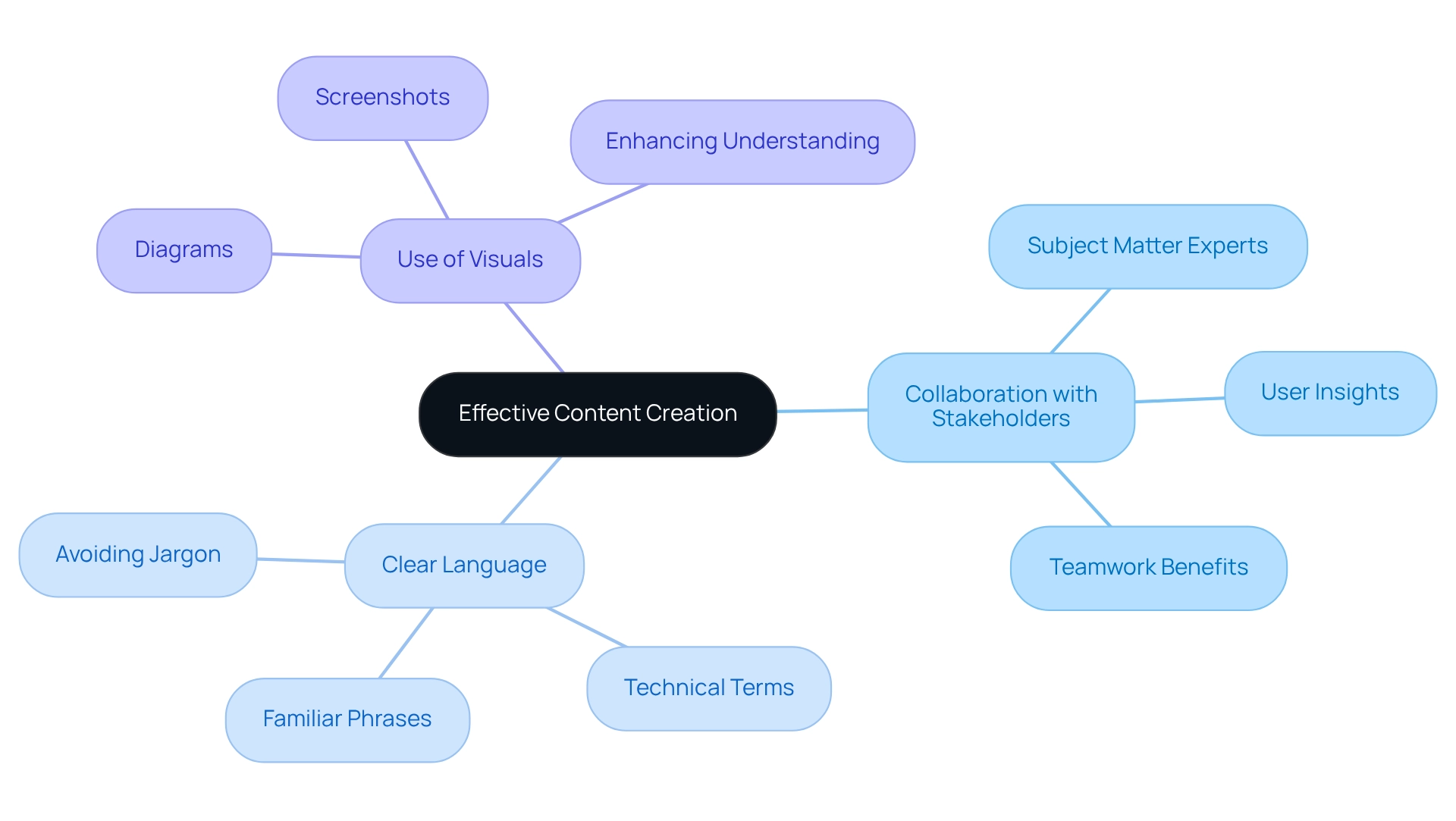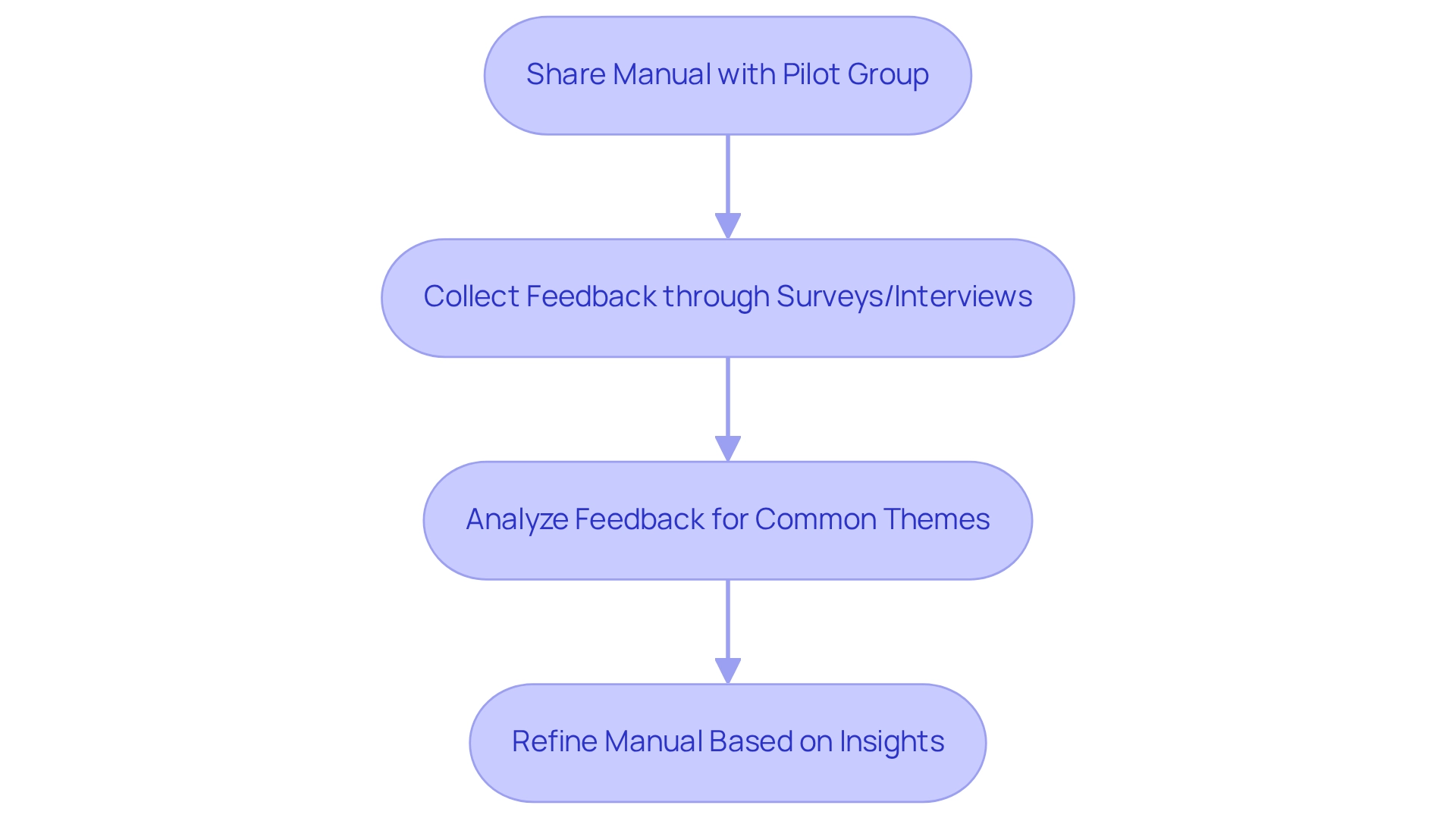
Automation and Documentation
|
July 15, 2025
|
How to Make Training Manual: Steps for Effective Documentation
Overview
Creating an effective training manual? You might be wondering where to start. First off, it’s all about:
- Defining your purpose
- Identifying your target audience
- Setting clear objectives
This way, you ensure that the content is not just relevant but also engaging for your users. Speaking of engagement, the article highlights how crucial it is to:
- Collaborate with stakeholders
- Use straightforward language
- Incorporate feedback mechanisms
This approach helps you continuously refine the manual, ultimately building a skilled and knowledgeable workforce. So, let’s dive into how you can make your training manual a success!
Key Highlights:
- Define the purpose of the training manual by outlining specific skills and knowledge it should provide.
- Identify the target audience, which may include new hires or current staff, to tailor the content effectively.
- Set clear objectives to maintain focus and relevance, addressing the trend of staff skimming compliance information.
- Research indicates Gen Z workers engage more with educational content, highlighting the need for tailored instructional methods.
- Organize content into coherent sections and develop a table of contents for easy navigation.
- Maintain a manageable scope by avoiding unnecessary details and focusing on key topics.
- Collaborate with stakeholders to ensure content accuracy and relevance, enhancing user engagement.
- Use simple, straightforward language and incorporate visuals to improve comprehension and retention.
- Establish a feedback loop by sharing the manual with a pilot group and gathering insights for continuous improvement.
- Analyze feedback for common themes to refine the manual, fostering a culture of inclusivity and continuous learning.
Introduction
In the world of employee development, you might be wondering how a well-crafted training manual can really make a difference. Think of it as a cornerstone for success, guiding individuals through the complexities of their roles. As organizations aim to enhance their onboarding processes and promote continuous learning, the importance of a clear, structured, and engaging training resource is huge. With all the diverse learning styles and varying levels of experience among employees, creating a manual that resonates with everyone is key.
Now, let’s dive into what makes an effective training manual. This article will explore the critical components of developing one, from defining its purpose and structure to collaborating on content creation and refining it through feedback. By doing so, we ensure that it remains a relevant and valuable asset in a workplace that’s constantly evolving. So, are you ready to explore how to make your training manual a game-changer?
Define the Purpose of Your Training Manual
To effectively create an instructional guide, one must understand how to make a training manual by clearly outlining its main goals. You might be wondering:
- What specific skills or knowledge should this guide provide to its users?
- Who is the intended audience—new hires, current staff, or a mix of both?
- And how will this guide support the broader aims of the company?
Writing down these objectives is key, as they’ll serve as a roadmap during the content creation process, keeping the guide focused and relevant. The importance of having well-defined objectives can’t be overstated. Did you know that 34% of staff skim over compliance information? This really highlights the need for clarity and engagement in educational materials. By setting clear goals, companies can tackle this trend and boost the effectiveness of their instructional materials.
Plus, research from McKinsey & Company shows that Gen Z workers interact more with educational content than previous generations. This underscores the need to tailor instructional methods to fit various learning preferences. As we look toward 2025, the role of instructional guides in organizations is more critical than ever. They not only make onboarding smoother but also improve staff performance by providing clear guidance.
According to SHRM, a lack of optimism about career development opportunities for upskilling—expressed by 29% of workers—highlights the need for accessible and focused learning paths. A well-articulated instructional guide on how to make a training manual can serve as a vital resource in addressing these challenges, fostering a culture of continuous education and growth.
By clearly defining the aim of your instructional guide on how to make a training manual, you can create a valuable resource that boosts engagement, aids in compliance, and ultimately leads to a more skilled and knowledgeable workforce. And let’s not forget about SowFlow’s innovative documentation solutions—they directly tackle the challenges of outdated documentation. This ensures that instructional guides not only align with employee needs and organizational goals but also stay fresh and relevant, transforming the documentation process into a scalable system.
Identify Scope and Structure of the Manual
To effectively outline the scope of your instructional guide, let’s explore how to make a training manual by diving into some essential steps together:
- Identify Key Topics: You might be wondering where to start. Begin by listing all subjects that are relevant to how to make a training manual. This way, you’ll cover all necessary information. With SowFlow, you can easily summon the wisdom of your documentation with a single command, making it simpler to identify and include relevant topics.
- Organize Content: Now, let’s talk about grouping related topics into coherent sections or chapters. This helps establish a logical progression that improves comprehension. SowFlow's intuitive tools enable seamless structuring, ensuring your guide is thorough and simple to navigate.
- Develop a Table of Contents: Create a table of contents to visualize the structure of your guide. This not only aids in navigation but also gives a clear overview of the content. Plus, SowFlow facilitates instant updates, so your table of contents can always reflect the most current information.
- Maintain a Manageable Scope: It’s important to keep the scope focused and manageable. Avoid unnecessary details that could distract from the main objectives. A carefully designed staff development program is the first step toward success, laying the groundwork for effective learning and growth, and is essential when learning how to make training manual updates and modifications that align with research showing that firms offering extensive instruction are more likely to lead their sectors. In fact, 53% of entities provide leadership skills development, highlighting the significance of organized instructional guides in promoting staff involvement and satisfaction. Interestingly, 68% of staff members feel that the instruction they receive is adequate for their positions, yet 55% express a desire for additional development opportunities. By balancing the development offered with employee expectations, organizations can enhance their workforce's capabilities and overall performance, all while leveraging SowFlow's innovative documentation solutions.
Want to learn more about how SowFlow can simplify your instructional guide creation? Contact us!
Collaborate on Content Creation and Use Clear Language
Involving relevant stakeholders in the content creation process is super important for understanding how to make a training manual effectively. You might be wondering why? Well, collaborating with subject matter experts ensures that the information presented is spot on, and engaging potential users offers valuable insights into their needs and preferences. This teamwork not only boosts the guide's relevance but also fosters a sense of ownership among users, leading to better adoption and utilization.
Now, let’s talk about language. Using simple, straightforward language throughout the guide is key. Avoiding jargon unless absolutely necessary helps make the content accessible to everyone. And when you have to use technical terms, providing clear explanations can really enhance comprehension. For example, instead of complex terminology, try using familiar phrases that convey the same meaning. This way, all employees can easily grasp the material.
Incorporating visuals, like diagrams or screenshots, can also enhance understanding and retention of complex concepts. Visual aids break down information into bite-sized pieces, making it easier for users to follow along and apply what they learn. Studies show that effective communication, especially with visuals, can significantly improve task completion rates and stakeholder satisfaction, ultimately leading to a more engaged workforce.
Let’s not forget about the power of stakeholder participation. Case studies highlight how this involvement can boost the effectiveness of how to make training manual. For instance, organizations that tailored their engagement strategies to different stakeholder segments saw improved contributions and overall engagement. By developing specific strategies for each group, they maximized the value of their educational resources. This just goes to show that collaboration isn’t just beneficial; it’s crucial for success. As Simon Sinek puts it, 'Together is better.' This principle really underscores the importance of working together to create instructional guides that truly meet the needs of all users.

Gather Feedback and Refine the Manual
To keep your training guide effective and relevant, establishing a solid feedback loop is key. You might be wondering how to make a training manual; well, begin by sharing the manual with a pilot group of users. Encourage them to share their thoughts on clarity, relevance, and usability. This initial feedback is crucial! Research shows that timely and actionable insights are essential; in fact, did you know that 50% of staff evaluations are overdue by at least one month? That really highlights how important it is to gather feedback quickly.
Now, let’s talk about how you can gather that feedback. Consider using surveys or conducting interviews to collect structured insights. This approach not only gives you quantitative data but also opens the door to qualitative insights that can uncover deeper issues. For example, organizations that really listen to their staff, like Celadon Trucking, have seen significant improvements—like a 68% reduction in workforce attrition. That’s a testament to the value of incorporating user input into your processes!
Once you have that feedback in hand, it’s time to analyze it for common themes and areas that need improvement. This step is super important; only 26% of employees think annual performance reviews are effective. That’s a clear gap that can be bridged through continuous feedback mechanisms. By updating your guide based on this analysis, you’re transforming it into a living document that can adapt to changing needs and user feedback over time.
Integrating user input doesn’t just enhance the guide's effectiveness—it also fosters a culture of inclusivity and belonging within the company. As organizations move away from traditional performance reviews toward more dynamic feedback systems, the role of user input in refining documentation becomes even more critical. By prioritizing feedback, you’re not just learning how to make a training manual; you’re crafting a resource that genuinely meets your team’s needs, ultimately boosting performance and morale.

Conclusion
Creating an effective training manual is key to helping your employees grow and boosting your organization's success. You might be wondering how to start? By clearly defining the manual's purpose, you can make sure it covers the specific skills and knowledge your audience needs. This foundational step keeps the content relevant and aligns with your broader organizational goals, paving the way for a more engaged and skilled workforce.
Now, let’s dive into structuring the manual. A logical flow and comprehensive coverage of key topics are equally important. A well-organized training manual, complete with a clear table of contents, makes it easy to navigate and helps employees quickly find the information they need. This structured approach not only supports effective onboarding but also enhances ongoing learning opportunities, catering to the diverse needs of your team.
Speaking of collaboration, involving others in content creation is another critical aspect. It allows you to include expert insights and user perspectives. Plus, simplifying the language and adding visuals can boost comprehension and retention, making the training manual accessible to everyone. By fostering a sense of ownership through stakeholder involvement, you can create training resources that are not only informative but also widely adopted.
Finally, let’s talk about feedback. Establishing a feedback loop to continuously refine the manual ensures it stays relevant and useful over time. Gathering insights from users and making necessary adjustments fosters a culture of continuous improvement, ultimately leading to better performance and employee satisfaction. By prioritizing these key components, you can transform your training manuals into invaluable assets that drive engagement, support development, and contribute to long-term success.
Frequently Asked Questions
What are the main goals when creating an instructional guide?
The main goals include identifying specific skills or knowledge the guide should provide, determining the intended audience (new hires, current staff, or both), and understanding how the guide will support the broader aims of the company.
Why is it important to write down the objectives of the instructional guide?
Writing down the objectives serves as a roadmap during the content creation process, keeping the guide focused and relevant, which enhances clarity and engagement in educational materials.
How does the engagement level of employees with educational content vary among generations?
Research from McKinsey & Company indicates that Gen Z workers interact more with educational content than previous generations, highlighting the need to tailor instructional methods to fit various learning preferences.
What challenges do organizations face regarding employee development and upskilling?
A lack of optimism about career development opportunities for upskilling has been expressed by 29% of workers, indicating a need for accessible and focused learning paths.
How can a well-articulated instructional guide benefit organizations?
It can foster a culture of continuous education and growth, improve staff performance by providing clear guidance, and make onboarding smoother.
What role do innovative documentation solutions, like SowFlow, play in instructional guides?
They tackle the challenges of outdated documentation, ensuring that instructional guides align with employee needs and organizational goals while remaining fresh and relevant.
👍
What others are liking
5 Steps to outline your ideal documentation structure
5 MINS READ
Where to start the your journey of mapping out your ideal documentation structure, aligning it with the very heartbeat of your organization?
Defining a winning level of detail in your process
3 MINS READ
What is too much detail, and what is too little? This article described in that winning level detail about what detail is enough.





